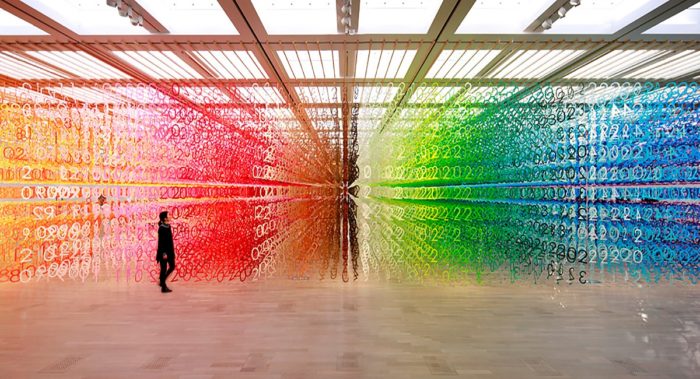Chakra Colour Meaning And Its Significance
Chakra colours are how the specific energy frequencies of the seven primary chakra energy centres express themselves in the human aura.
By looking at these unique to each person aura colours and how they appear around the body, we can find out a lot about the chakras and the metaphysical health of the individual.
If an individual has an intense or disruptive energy build up in one of the chakras, it will have visible effects in the aura. Looking at the colour, we can tell which chakra is activated.
Whether you are experiencing the symptoms of chakra blockage or overactivation, or you are just trying to learn more about the chakras, this handy guide can serve as the first port of call – you might even want to add it to your bookmarks!
Red – Root Chakra
Starting at the beginning of the human chakra system, the Root chakra forms the base through which all metaphysical awakenings and energy must flow.
It is the colour red, and when it is excited with energy, it glows around the reproductive system.
When red takes over the aura, it can symbolise difficulties with base needs like love, water, shelter and safety. Stress over paying the bills or other immediate problems can cause overactivation of the Root chakra, as can traumatic experiences.
The Root chakra is intimately connected to your physical body, so health problems can also show red in your aura. This show of red is particularly true for inflammation.
Bring yourself back in tune with your Root chakra by meditating in a seated position and allowing the Earth’s energy to enter you through the ground and via the Root chakra.
Orange – Sacral Chakra
Red the colour of the Root chakra represents our animal selves. It is true that the orange of the Sacral chakra symbolises our social self.
This chakra shows orange and when excited it glows around the abdomen.
Orange takes over the aura when the Sacral chakra is blocked, which usually indicates emotional problems. This could be an inability to express your feelings, but it could just as easily be a feeling of lack of control over emotions.
As well as digestive problems, this can include frustration, over-indulgence, unpleasant past experiences and anything relating to emotions.
Aside from addressing any obvious problems, creativity is one way of helping problems with the Sacral chakra. Painting, writing, music – these are all great ways of expressing your emotions in a way that is easier on the ego.
Yellow – Solar Plexus Chakra
The Solar Plexus chakra often symbolises our higher animal traits, such as intellect, will, ego and the self.
It vibrates at the same frequency as the colour yellow, often glowing around the torso when activated or excited. This can happen when we take on difficult mental tasks and succeed, or when we receive recognition.
When yellow starts to take over the aura from the Solar Plexus, especially if it is muddy, it might indicate mental deterioration or low self-esteem. Being made to feel stupid is the most common cause of this.
To turn that muddy yellow into a brighter, healthier one, we have to address the problems of the Solar Plexus. This means finding ways to be more confident, spending time on intellectual pursuits and challenging ourselves.
Green – Heart Chakra
The Heart chakra forms the bridge between the physical and the metaphysical, or the lower and higher chakras.
Its colour is green, the colour it glows around the chest when activated. This happens when we fall in love, when we spend quality time with family and when we forge a new connection with someone else.
Muddy greens taking over the aura can indicate a lack of love, loneliness and depression. Losing someone close to us or somebody betraying us or changing for the worse can also cause these problems.
The best Heart chakra medicine is time, though balancing the green in your aura is best achieved by being around the people we love. Support systems are essential for your metaphysical health.
Blue – Throat Chakra
The Throat chakra deals with speech and expression.
Lighter blues indicate Throat chakra activation, which is often achieved by successful self-expression. Feeling able to speak in front of people and being comfortable sharing your thoughts with others are great for the Throat chakra.
Muddy or grey blues can indicate blockages in the Throat chakra, possibly caused by an inability to express yourself. Stammering, social anxiety and general repression can spread these energies in your aura, though the same is true for over-expression resulting in embarrassment and anxiety.
Healing the Throat chakra involves learning to express your inner self without fear of judgement, without going too far the other way and becoming prone to blabbering. Positive thinking and meditation help, but there is no replacement for forcing yourself to do public speaking.
Deep Purple & Indigo – Third Eye Chakra
The colours become more varied for the highest two chakras. The Third Eye chakra deals with perception, intuition and wisdom.
Its colours range from deep-to-mid-purples and pinks to deep blues and indigo. The glow of activation appears around the head, especially in or around the eyes, ears and nose. This happens when we use our intuition, impart or receive wisdom, or witness something spiritual or supernatural.
Muddier versions of these colours can indicate problems with the senses such as vision or hearing loss. However, it might also cause an inability to focus and make metaphysical practice less effective by weakening the intuition.
More about purple chakra
White & Violet – Crown Chakra.
The Crown chakra is the seventh and final primary chakra and governs our higher self and our interactions with souls and the metaphysical world.
Depending on intensity, the colour of this chakra can range from light pinks and purples all the way to the brightest white. The glow usually appears around the top of the head, sometimes looking like a halo. Activation requires a rise in vibration and a move towards higher dimensions of consciousness, though lesser activation might occur while pondering oneness and existence.
Problems that might muddy these colours include detachment from your inner self, an overpowering ego or a lack of understanding of the idea of universal oneness.
We hope that you find this guide helpful. If you do, bookmark this page and perhaps it will be useful to you again in the future!






